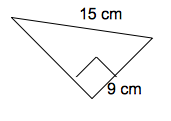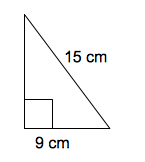All Basic Geometry Resources
Example Questions
Example Question #291 : Right Triangles

Triangle ABC has the given side lengths. Find the area of triangle ABC.
Imagine a right triangle as a square cut in half at a diagonal angle.
When figuring out the area, you figure it out the same way as finding the area of a square, but after multiplying length x width, divide the answer by 2.
Example Question #1469 : Plane Geometry
Find the area, , of a right triangle whose sides are , , .
The formula for the area of a right triangle is
.
Plugging in the values given,
.
Example Question #1470 : Plane Geometry

In the right triangle shown here, and . What is its area in square units?
The area of a right triangle is given by , where represents the length of the triangle's base and represents the length of the triangle's height. The base and the height of the triangle given in the problem are and units long, respectively. Hence, the area of the triangle can be calculated as follows:
.
Hence, the area of a right triangle with base length units and height units is square units.
Example Question #1471 : Basic Geometry
Are the two right triangles congruent?
Yes, by AAA
Yes, by AAS
Yes, by HL
No, they are not congruent
Yes, by AAA
Yes, by HL
Right triangles are congruent if both the hypotenuse and one leg are the same length. These triangles are congruent by HL, or hypotenuse-leg.
Example Question #1 : How To Find If Right Triangles Are Congruent
Which of the following is not sufficient to show that two right triangles are congruent?
The hypotenuse and one leg are congruent.
Both legs are congruent.
All the sides are congruent.
All the angles are congruent.
All the angles are congruent.
Two right triangles can have all the same angles and not be congruent, merely scaled larger or smaller. If all the side lengths are multiplied by the same number, the angles will remain unchanged, but the triangles will not be congruent.
Example Question #1471 : Basic Geometry
Which of the following pieces of information would not allow the conclusion that

bisects
To determine the answer choice that does not lead to congruence, we should simply use process of elimination.
If , then subtracting tells us that .; therefore . Given the fact that reflexively and that both and are both right angles and thus congruent, we can establish congruence by way of Side-Angle-Side.
Similarly, if , then , and given the other information we determined with our last choice, we can establish conguence by way of Hypotenuse-Leg.
If , given what we already know we can establish congruence by Angle-Angle-Side
Finally, if is an angle bisector, then our two halves are congruent. . Given what we know, we can establish congruence by Angle-Side-Angle
The only remaining choice is the case where . This does not tell us how the two parts of this angle are related, we lack enough information for congruence.
Example Question #291 : Right Triangles
Complete the congruence statement

Since we know that , we know that is also a right angle and is thus congruent to .
We are given that . Furthermore, since and are vertical angles, they are also congruent.
Therefore, we have enough evidence to conclude congruence by Angle-Side-Angle. Vertex matches up with , vertex matches up with , and matches up to . Thus, our congruence statement should look the following
Example Question #5 : How To Find If Right Triangles Are Congruent
Figures and are triangles.

Are and congruent?
Yes.
No.
There is not enough information given to answer this question.
Yes.
We know that congruent triangles have equal corresponding angles and equal corresponding sides. We are given that the corresponding sides are equal and are in the ratio of . A triangle whose sides are in this ratio is a , where the shortest side lies opposite the angle, the longest side is the hypotenuse and lies opposite the right angle, and the third side lies opposite the angle. (Remember .) So we know the corresponding angles are equal. Therefore, the triangles are congruent.
Example Question #2 : How To Find If Right Triangles Are Congruent
Figures and are triangles.

Are and congruent?
There is not enough information given to answer this question.
No.
Yes.
Yes.
We know that congruent triangles have equal corresponding angles and equal corresponding sides. We are given that the corresponding sides are equal and are in the ratio of .
Simplify the ratio by dividing by
Thus, the corresponding sides are in the ratio and we know both triangles are triangles. Since the corresponding angles and the corresponding sides are equal, the triangles are congruent.
Example Question #1 : How To Find If Right Triangles Are Congruent
Figures and are triangles.

Are and congruent?
No.
There is not enough information given to answer this question.
Yes.
Yes.
We know that congruent triangles have equal corresponding angles and equal corresponding sides. We are given that the corresponding sides are equal, and the measures of two angles. We know that and because the sum of the angles of a triangle must equal . So the corresponding angles are also equal. Therefore, the triangles are congruent.
Certified Tutor
Certified Tutor
All Basic Geometry Resources










































































































